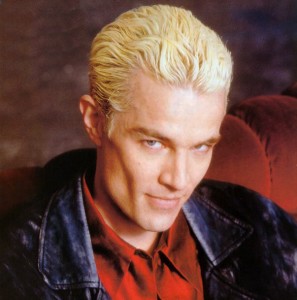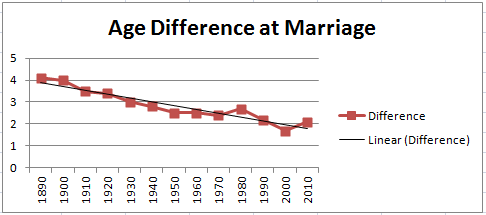 Editor’s note: Want to contribute a guest blog post? Contact us.
Editor’s note: Want to contribute a guest blog post? Contact us.
By Samuel Scott
“Buffy the Vampire Slayer” is often portrayed — especially by its creator, Joss Whedon, and the actors who starred in it — as a television program that celebrated feminism and ushered in an era of so-called girl-power embodied by the later arrival of many strong, female characters on TV and in film. Others, however, have criticized the show and said that it is not as feminist as is commonly thought, and I wish to agree, albeit for a different reason. (1) Most (though not all) of the heterosexual relationships in “Buffy,” for better or worse, exemplify pre-feminist trends in society generally and dating specifically that existed long before the show premiered in 1997 and contradict the trends in the same areas at that time the show aired.
For untold centuries (if not since the dawn of history), women have tended to marry older men:
The tendency for women to prefer older partners, and for men to prefer younger partners, has frequently been explained in terms of socialization to American sex-role norms specifying that men must be older and more powerful than their female partners. However, recent cross-cultural data reveal this same pattern in all societies studied, a finding more in line with an evolutionary life-history model.
Another study found that a “consistent cross-cultural preference by women for at least same-age or significantly older men.” In Europe, “most men marry women around three years younger.” Of course, such findings should not surprise any casual observer of the dating scene in nearly any country or culture today.
Now, examine the major heterosexual pairings (real, or desired on the part of the female) in “Buffy”:
- Buffy dates Angel, who states his age in Season 2 as 241 (see a continuity error), from the age of sixteen to eighteen, and she tells her mother in Season 1’s “Angel” that he is a college student who is tutoring her
- Cordelia at seventeen dates a college student in a fraternity, and Buffy expresses interest in a similarly-aged man at a party at their university residence (see Season 2’s “Reptile Boy”)
- Cordelia develops a crush on Wesley, a new watcher who replaced Giles, during her senior year of high school
- Willow begins dating Oz during her junior year of high school, when he is a senior
- Dawn has a crush on Xander when she is roughly thirteen in Season 5
- Faith, who is roughly the same age as Buffy, sleeps with Sunnydale High School’s third principle, Robin Wood, who is ten years older than Buffy (according to in Season 7’s “First Date”) — and Buffy had gone on a date with him beforehand
- Buffy has sex with Spike, who is described in Season 2 as a roughly 200-year-old vampire
- Buffy sleeps with Parker, an older college-student, during her freshman year of college early in Season 4 and that same year develops a relationship with Riley, who is a graduate-student teaching assistant
- Julie Lee’s unnamed character in the first episode of Season 3 mourns her late boyfriend because, she tells Buffy, “he takes care of me”
Of course, there were heterosexual pairings that did not match this trend — namely, Xander and Cordelia, Xander and Anya over several years, Faith and Xander in Season 3, and Buffy and Scott that same year. However, these couples should be excluded from consideration in this present analysis because the couples in question, in the context of the series, were not composed of two inherently-human heterosexuals who were directly interested in long-term, romantic relationships. Xander and Cordelia’s short-lived relationship was based more the emotional high that they felt through their constant bickering rather than anything substantial. Anya, even after she had lost her vengeance-demon powers, did not fully understand humanity until late in Season 7. Faith used Xander for just a one-night stand. Season 3’s Scott (who broke up with Buffy), as we learn from a random vampire in Season 7’s “Conversations with Dead People,” was actually gay.
In short, in nearly every instance in “Buffy the Vampire Slayer” of a heterosexual, insecure, young, human woman pursuing a heterosexual male for some type of a long-term relationship, the woman prefers and desires an older, confident, domineering, so-called “alpha male.” And that, it could be argued, is not very feminist. (Although, admittedly, it may depend on how one defines the term “feminist.”)
The first male she meets who is neither a friend, principal, nor watcher is, of course, Angel in the Season 1 episode “Welcome to the Hellmouth.” Their initial exchange sets the tone for the type of man whom Buffy and almost all of the heterosexual characters would desire sexually. Angel is a confident, mysterious, alpha-male, older man who teases Buffy to the point of making fun of her:
- “The truth is, I thought you’d be taller. Or bigger muscles, and all that.”
- “Who are you,” Buffy asks. “Let’s just say, ‘I’m a friend,'” Angel replies with a coy smile before walking away.
- “Yeah, well, maybe I don’t want a friend,” Buffy says in response. “I didn’t say I was yours,” he replies with a smirk.
Later, Buffy describes Angel to Giles as “this guy — dark, gorgeous, in an annoying sort of way… I really didn’t like him.” Her flustered tone and body language reveal that she was deeply attracted to him. The “dating tactics” that Angel uses — his dismissive, teasing tone towards a girl who is insecure (as a result of her slayer role and her newness in town) — are prefect examples of what is called “Game” among single men today, and it is a system that purports to teach men how to become “alpha males” and seduce women. Of course, feminism would not endorse such attitudes and tactics.
Dating, Buffy, and Feminist Thought
Moreover, all of the relationships described earlier fit the same general mold and/or demonstrate other forms of female desire that feminism would surely not find palatable:
- Cordelia dates for money and/or the lead singer of the popular local band
- Willow, who was very insecure until Season 4, begins dating Oz, a confident, older, male guitarist with a sarcastic attitude towards pretty much everything
- Faith develops her first real connection with a male in Robin Wood, who is confident and assertive enough to put her in her place in Season 7
- Buffy sleeps with Spike, who is an aggressive, angry, “bad boy” of a vampire
- Buffy is manipulated into a one-night stand by Parker, a player who had likely read his fair share about “Game”
- Buffy’s last (official?) boyfriend in the television series is Riley, whose military-officer job exemplifies the authoritative, conservative, commanding male — after all, it seems that women often say that they “love a man in uniform”
In short, when one examines the type of men with whom heterosexual women in the Buffyverse choose to have relationships, nearly all of them are the type of man whom, feminism would likely argue, women should avoid and instead date the 1990s type of male — one who sensitive, caring, and “in touch with his feminine side.” Angel, Spike, and others surely did not fit this mold. Xander did — and Buffy never developed even a little bit of sexual interest in him.
In fact, gender relations in “Buffy the Vampire Slayer” are reminiscent of a time long before the 1990s in another way. Take this chart of the average male-female age disparity at first marriage, which I created using U.S. Census data:
By the late 1990s, when “Buffy” premiered, men and women were marrying each other when they were very close to the same age — signifying, perhaps, a trend that the two sexes were becoming more equal in societal terms. (An interesting side note: There is an uptick in the age difference during times of economic distress, as in the late 1970s and the present day — perhaps signifying a female need for an older man with more financial resources.) However, as we see throughout “Buffy,” the dichotomy between men and women was a throwback towards something much older (in terms of time and male boyfriends) and traditional than what would be typical for a television show that appeared in 1997.
Samuel Scott is the founder and publisher of Buffy the Vampire Slayer Online. You can follow him on Facebook, LinkedIn, Google+, and Twitter as well as on his personal website.
—
(1) Popular critiques of the feminism in “Buffy” include “And Yet: The Limits of Buffy Feminism” by Renee St. Louis and Miriam Riggs, “Buffy the Feminist Slayer? Constructions of Femininity in Buffy the Vampire Slayer” by Gwyneth Bodger, “Is Joss Whedon a Feminist? Buffy and Female Empowerment” by S. E. Smith, and “Why Buffy The Vampire Slayer is not a feminist show” by an unknown blogger.
Like this post? Submit it to Whedonesque!







